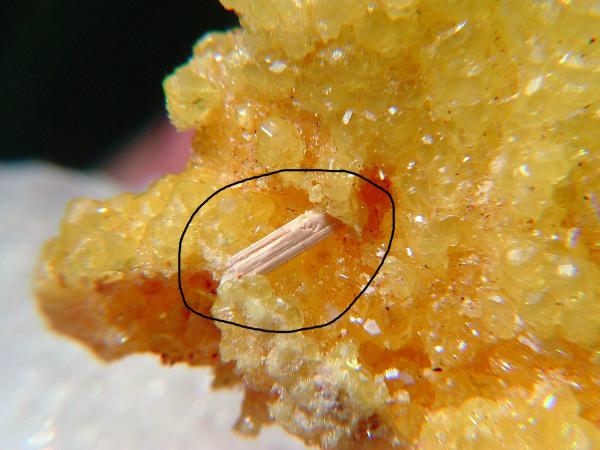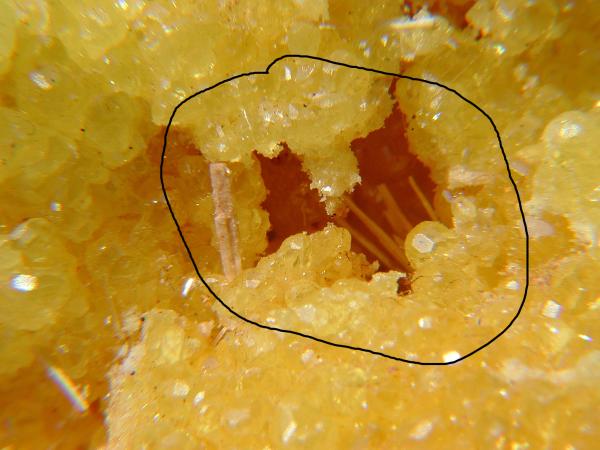| View previous topic :: View next topic |
| Author |
Message |
rockbottom

Joined: 12 Sep 2007
Posts: 30
Location: Miami, FL


|
 Posted: Mar 14, 2008 19:53 Post subject: Sulphur and ??? Posted: Mar 14, 2008 19:53 Post subject: Sulphur and ??? |
|
|
Greetings to all! Got this piece of Sulphur which is associated with some sort of unknown mineral; does anybody know what it is? There is no location given but I am 99.99% it is from Mexico but I could be wrong, check it out!
| Description: |
|
| Viewed: |
58639 Time(s) |

|
| Description: |
|
| Viewed: |
58631 Time(s) |

|
|
|
| Back to top |
|
 |
alfredo
Site Admin

Joined: 30 Jan 2008
Posts: 1011



|
 Posted: Mar 15, 2008 08:43 Post subject: Re: Sulphur and ??? Posted: Mar 15, 2008 08:43 Post subject: Re: Sulphur and ??? |
|
|
Break out one of the crystals and check whether it's soluble in water. Could be one of the aluminium sulphates - they are not uncommon together with sulphur from volcanic fumaroles. The sulphur might be from the El Desierto mine in Bolivia - I've seen similar white prismatic crystals on sulphur there.
Alfredo
|
|
| Back to top |
|
 |
Brokenstone

Joined: 29 Jul 2007
Posts: 20
Location: Cantabria



|
 Posted: Mar 15, 2008 10:34 Post subject: Re: Sulphur and ??? Posted: Mar 15, 2008 10:34 Post subject: Re: Sulphur and ??? |
|
|
Good morning, It be possible gypsum crystals?
Greetings
Pablo
_________________
Kisses are like as silver or gold nuggets, marvelous, because will be advise at the presence, of the mine. |
|
| Back to top |
|
 |
lluis
Joined: 17 Nov 2006
Posts: 719


|
 Posted: Mar 15, 2008 15:29 Post subject: Re: Sulphur and ??? Posted: Mar 15, 2008 15:29 Post subject: Re: Sulphur and ??? |
|
|
Good afternoon
I would think as Alfredo, an aluminium sulphate.
For gypsum, those tiny crystals should be transparents.
If any tiny bit could be had, then I could suggest some tests....
With best wishes
Lluís
|
|
| Back to top |
|
 |
Pete Modreski
Site Admin

Joined: 30 Jul 2007
Posts: 710
Location: Denver, Colorado



|
 Posted: Mar 15, 2008 16:54 Post subject: Re: Sulphur and ??? Posted: Mar 15, 2008 16:54 Post subject: Re: Sulphur and ??? |
|
|
I was going to suggest a sulfate mineral too. Celestine can look like that, but there are many others--halotrichite and pickeringite are two that have fibrous habits.
Pete
|
|
| Back to top |
|
 |
Brokenstone

Joined: 29 Jul 2007
Posts: 20
Location: Cantabria



|
 Posted: Mar 17, 2008 07:31 Post subject: Re: Sulphur and ??? Posted: Mar 17, 2008 07:31 Post subject: Re: Sulphur and ??? |
|
|
Hi everybody, one question for Lluis and for all , Its anhydrous gypsum possible? In the Desierto Mine has found anhydrite and gypsum with the sulphurs, allum sulphates too.
Thanks
Pablo
_________________
Kisses are like as silver or gold nuggets, marvelous, because will be advise at the presence, of the mine. |
|
| Back to top |
|
 |
alfredo
Site Admin

Joined: 30 Jan 2008
Posts: 1011



|
 Posted: Mar 17, 2008 11:24 Post subject: Re: Sulphur and ??? Posted: Mar 17, 2008 11:24 Post subject: Re: Sulphur and ??? |
|
|
| Pablo, Gypsum in fumaroles and hot springs sometimes dehydrates to Bassanite, forming opaque white pseudomorphs after gypsum. You'll need at least a powder XRD to be sure of the ID. This can happen any time the temperature rises above 70 degrees for a few days, which of course is common in fumaroles.
|
|
| Back to top |
|
 |
Brokenstone

Joined: 29 Jul 2007
Posts: 20
Location: Cantabria



|
 Posted: Mar 17, 2008 13:04 Post subject: Re: Sulphur and ??? Posted: Mar 17, 2008 13:04 Post subject: Re: Sulphur and ??? |
|
|
Thank you Alfredo for your explanation, in the photo 1of the mr. rockbottom appreciate differences between the crystals most deep which appear more transparent and definite, the intermediate crystals in which there estimates certain pseudomorfism and the crystal of the photo 2 that on having been in the exterior has dehydrated and lost his definition. This would have to see with the thermal differences between the exterior and the interior of the piece. I hope that the Mr. Rockbottom could effect some test on the piece.
Regards
Pablo
_________________
Kisses are like as silver or gold nuggets, marvelous, because will be advise at the presence, of the mine. |
|
| Back to top |
|
 |
lluis
Joined: 17 Nov 2006
Posts: 719


|
 Posted: Mar 17, 2008 16:35 Post subject: Re: Sulphur and ??? Posted: Mar 17, 2008 16:35 Post subject: Re: Sulphur and ??? |
|
|
Good evening, Pablo, Alfredo/list
Well, I have a trouble. I could understand that aluminium sulphate could be "volatilized" in a fumarole.
Not gypsum. It only dehydrates, later decomposes...and calcium oxide only "volatilizes" at very high temperature, as far as I know...
If water is present, a calcium salt is liikely. Without water, I still believe more in an aluminium salt
But as said, a small sample, and all would be solved.
Aluminium has some specific reactions that calcium do not do......
With best wishes
Lluís
P.D.: small means small, less than a mg.....
|
|
| Back to top |
|
 |
alfredo
Site Admin

Joined: 30 Jan 2008
Posts: 1011



|
 Posted: Mar 17, 2008 18:52 Post subject: Re: Sulphur and ??? Posted: Mar 17, 2008 18:52 Post subject: Re: Sulphur and ??? |
|
|
| Lluis, The Ca in the gypsum, and the K-Na-Mg-Fe-Al in other sulphates, all come from the decomposition of feldspars (and lesser amount of micas and inosilicates) in the host rock of the fumarolic fissure, after the feldspars are attacked by sulphuric acid vapours. I don't think the Ca-Al-etc were ever themselves volatilized, but I might be wrong.
|
|
| Back to top |
|
 |
lluis
Joined: 17 Nov 2006
Posts: 719


|
 Posted: Mar 18, 2008 15:29 Post subject: Re: Sulphur and ??? Posted: Mar 18, 2008 15:29 Post subject: Re: Sulphur and ??? |
|
|
Good afternoon, Alfredo/List
Well, I just know some chemistry, not at all an expert in mineralogy.
It is difficult for me seeing that a silicate is attacked by sulphuric acid, but well, with time and temperature, all could finally happen.
I rationalized the aluminium sulphate as first creating aluminium chloride, that could sublimate at relatively low temperatures ( 177.8ºC at one atmosphere). That low temperature of sublimation is also a driving force that easies the formation
Then, the vapours of SO3 plus the humidity could do the wonder of changing it to aluminium sulphate (HCl is just a gas)
The temperatures are low enough not to disturb the sulphur…Sulphur boils at 444.7ºC
I could not imagine a route for gypsum, unless water liquid is present and the crystals were formed by evaporation of water solutions.
But as I said, I am only chemist.
With best wishes
Lluís
|
|
| Back to top |
|
 |
Les Presmyk
Joined: 06 Dec 2007
Posts: 372
Location: Gilbert, AZ


|
 Posted: Mar 18, 2008 15:55 Post subject: Re: Sulphur and ??? Posted: Mar 18, 2008 15:55 Post subject: Re: Sulphur and ??? |
|
|
| I would point out there are many silicate minerals easily attacked by numerous acids and under most conditions, even quartz is dissolved under the high temperature and pressure. At multiple atmospheres and 700 degrees Centrigade, all sorts of interesting things can happen. But, even at room temperatures and low concentrations, feldspars, chrysocolla and dioptase are three silicates that are attacked by acidic solutions. This is a bit afield from fumaroles but just a reaction to the statement about silicates and sulfuric acid.
|
|
| Back to top |
|
 |
alfredo
Site Admin

Joined: 30 Jan 2008
Posts: 1011



|
 Posted: Mar 18, 2008 16:32 Post subject: Re: Sulphur and ??? Posted: Mar 18, 2008 16:32 Post subject: Re: Sulphur and ??? |
|
|
| Les is correct. All the minerals in a typical volcanic rock are easily attacked by hot sulphuric acid, except for muscovite and quartz. Consequently in rock around fumaroles we often find pseudomorphs of native sulphur after feldspar phenocrysts! I've seen these pseudomorphs myself in fumaroles in Japan, Bolivia and Ethiopia. Maybe the attack is accelerated by the fact that volcanic H2SO4 is usually impure and contains traces of HF and HCl too - Not too good for our lungs!
|
|
| Back to top |
|
 |
lluis
Joined: 17 Nov 2006
Posts: 719


|
 Posted: Mar 19, 2008 02:56 Post subject: Re: Sulphur and ??? Posted: Mar 19, 2008 02:56 Post subject: Re: Sulphur and ??? |
|
|
Good morning, Les/Alfredo/List
Yes, you are right. Chrisolla, dioptase, natrolite and the hydrated silicates are easily attacked by acidic solutions.
I forget to mention "not hydrated" silicates
I really thought that feldspars are attacked by acids so slow that count not. Well, "with time and temperature" all could happen.
But as chemist, I am used to handle sulphuric acid in glass bottles, that more or less could be as (few) reactive as a feldspar....
In presence of fluorhidric acid, certainly reaction speeds up: fluorhidric makes the fluorosilicate that is decomposed by the sulphuric fumes. Then, no objection about speed of attack (same glass, with sulphuric and added a little bit fluorite, and is inmediately attacked)
But if the rock matrix is covered by sulphur, I still could not see how the cations are movilized to the surface, unless is that vapour phase reaction that I could imagine for aluminium
Anyway, without an analysis, is only talking. One thing I could rationalize, the other not, so I prefer the one I could explain. If analysis prove another, then, I should rearrange my mind.
With best wishes
Lluís
|
|
| Back to top |
|
 |
rockbottom

Joined: 12 Sep 2007
Posts: 30
Location: Miami, FL


|
 Posted: Mar 26, 2008 00:45 Post subject: Re: Sulphur and ??? Posted: Mar 26, 2008 00:45 Post subject: Re: Sulphur and ??? |
|
|
Thank you all for the interesting conversations about this strange growth, unfortunately I did not test the secondary mineral as suggested, I did not want to damage it.
Gratefully yours,
rockbottom
|
|
| Back to top |
|
 |
|





